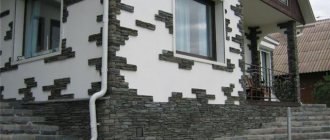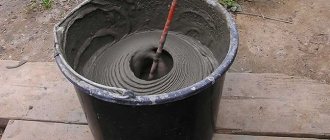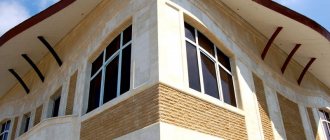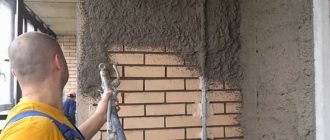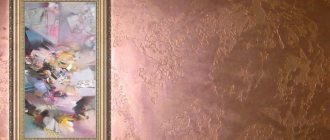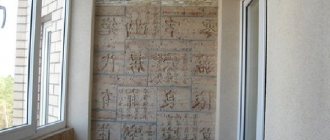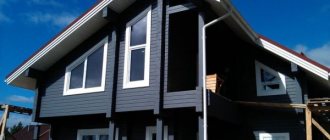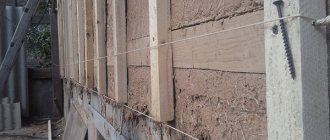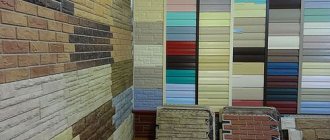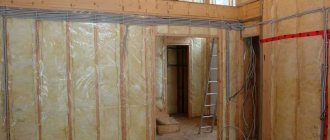Gas silicate blocks are an excellent building material. Their designs are warm and reliable. But after construction, the question arises: how is plastering of gas silicate building blocks done from the inside? There is a special technology for performing the work, which we will consider. This will help quickly and efficiently prepare walls made of gas silicate blocks for finishing from the inside.
Briefly about aerated concrete
This material is produced in industrial production by autoclaving.
Otherwise, it can be done using another method, when the poured mixture hardens in special forms during normal operations. The first method is more preferable, since blocks are created with a high level of strength, so that they can be freely used in the construction of load-bearing walls. This is mainly building material of the D500 and D600 brands. The composition of cellular aerated concrete blocks contains quartz sand, lime, water and aluminum powder as a gas generator. During the chemical reaction, gas bubbles appear and distribute in the mixture, creating numerous pores.
Advantages of using aerated concrete
The air present in the pores of the blocks gives them thermal insulation qualities, in addition to which the material has a number of the following advantages:
- It is environmentally friendly. There are no substances harmful to health in the composition of aerated concrete.
- The weight of the products is quite small, so that it does not create a significant load on the foundation of the building, but its selection and construction must be approached with special care, since cracks on the surface of aerated concrete masonry occur due to its mobility. Taking this into account, experts recommend laying aerated concrete on a strip-monolithic base.
- Aerated concrete blocks are fire-resistant and can withstand the influence of an open source of fire for over 5 hours, preventing its spread. This material is optimally used for fire protection of metal structures.
- These blocks have high frost resistance, which is ensured due to the spread of frozen liquid into the free dry pores inside the products when the air temperature decreases.
- When the material is placed in water, it will float on its surface, which indicates a significant level of its resistance to moisture.
- Aerated concrete blocks are easily processed and laid. Even one person can freely perform work using them. Due to its low weight and the presence of end recesses, the material is easy to move, and its dimensions, which are several times larger than bricks, make it possible to construct a building much faster and with less mortar consumption.
Note! Some advantages of aerated concrete in the absence of additional finishing on the outside of the facade of the building turn into disadvantages.
Reasons requiring external plastering of an aerated concrete wall
Under the influence of dampness, aerated concrete masonry will begin to deteriorate over time, since water will in any case begin to penetrate into the outer layer of the material, which is capable of absorbing it. It is precisely because of this feature that products necessarily require additional treatment with suitable compounds. In addition, thanks to the application of plaster, the appearance of the facade becomes more attractive.
Note! As a result of getting wet and drying, aerated concrete blocks will not acquire negative consequences in the summer, but in winter the liquid accumulated in small pores will freeze and become ice. For this reason, the material will expand, causing it to become covered with cracks and acquire other defects.
Taking into account the above, by plastering aerated concrete on the outside of the house, it will be possible to eliminate freezing, moisture penetration, as well as the negative effects of snow and other precipitation. To do this, you can resort to using different materials; it is only important that they provide all the necessary conditions for the protection and proper ventilation of the treated walls.
We prepare the necessary tools and building materials
Preliminary preparation of building materials and the necessary tools will speed up the finishing work and increase their productivity.
To plaster gas silicate walls you should prepare:
- a rule designed to stretch the plaster mixture along the beacons. The length of the rule is selected depending on the distance between the beacons;
- metal guides, called beacons, to ensure flatness. The beacons serve as a guide when working with the rule;
- drill with attachment or mixer. They are used to ensure accelerated and uniform mixing of the plaster mortar;
- trowel and spatulas with an extended working surface. The tool is used for throwing and leveling the plaster mixture;
- plumb line, building level, tape measure. They are used in the marking process and are used for control during plastering activities.
You will also need a wide brush or roller to apply the primer composition to the surface of the blocks. To carry out the kneading, you need an appropriate container, and to fix the mesh you will need nails or dowels.
Tool for plastering walls
In addition to tools, you must purchase the following materials:
- adhesive mixture for priming. It provides increased adhesion of plaster to gas silicate blocks;
- mesh for surface reinforcement. Mesh reinforcement makes it difficult for cracks to form and strengthens the finishing layer;
- dry mix for plastering work. It is easy to purchase a ready-made composition for plaster in specialized stores.
Having prepared everything you need, proceed to work.
The most common plaster mixtures for aerated concrete
There are several types of facade plaster compositions that have proven themselves when working with aerated concrete:
| Types of plaster |
| Decorative facade plaster
|
| Cement-lime dry composition
|
| Ready-made silicone mixture
|
| Ready-to-use silicate solution
|
Most popular manufacturers
Plaster mixtures for finishing aerated concrete are available in the product lines of all major plastering manufacturers. Mixtures of popular brands are distinguished by exact correspondence of qualities to the declared indicators.
Among the popular manufacturers are the following companies:
- German concern Henkel (develops and produces plasters under the Ceresit brand);
- Austrian brand Baumit;
- the Knauf company, which initially produced gypsum mixtures, also produces cement-based mixtures;
- Krasland company;
- Bolars (Uniplast mixture);
- A number of plasters for aerated concrete are produced by the company Pobedit.
From the Ceresit line, the brands CT 24 and ST 77 and others are most often used for aerated concrete. ST 24 is a lightweight cementitious, frost-resistant, vapor-permeable plaster mixture for leveling for universal use. ST 77 – façade acrylic aerated concrete plaster, ST 35 – decorative “bark beetle” mixture for façade use.
Popular in the Baumit line are the cement-lime composition Baumit HandPutz for universal use, the silicone composition SilikonTop, the silicate mixture SilikatTop, and the acrylic Nanopor Top.
Among the Knauf mixtures suitable for aerated concrete walls are gypsum Knauf-Profi, gypsum polymer Eisberg, gypsum with polymer additives Rotband, Goldband, cement Grunband (thermal insulation), Sevener.
The Krasland company produces compositions specifically for aerated concrete walls, for example, Aerated Concrete-2.
Requirements for plaster on aerated concrete
The products have high moisture absorption and vapor permeability. Therefore, the main requirements for plaster are excellent protection of aerated concrete from moisture penetration. With all this, the mixture must also be vapor-permeable so as not to disturb air exchange. Then condensation will not accumulate.
Plaster for gas silicate blocks must meet the following parameters:
- High adhesion rates - about 0.4 MPa.
- Vapor permeability indicators are from 0.17 to 0.2 mg (m*h*Pa).
- Moisture absorption is less than 5% by weight.
- Frost resistance indicators – 50 cycles or more.
- Minimal shrinkage after drying.
- Density after drying is from 500 to 1 thousand kg/m3.
- Strength after drying is about 0.29 mPa.
- Compressive strength class CS1.
When wet, it should dry quickly. The minimum number of drying and wetting cycles is 250. By choosing the right plaster for the surface of an aerated concrete wall that meets most of the requirements, you can be sure that it will last for decades.
Types of plasters for aerated concrete
The most common and most inexpensive plaster for exterior work is cement-sand. But since its vapor permeability is only 0.09 mg/(m h Pa), it is not at all suitable for aerated concrete structures. Other types of plaster mixtures, such as mineral, silicate and silicone, have the necessary parameters. Let's look at the characteristics of each of them in more detail.
Mineral
Mineral-based plaster is an inexpensive material and is easy to make with your own hands. The main disadvantage is the limited color range, but since this coating is very paintable, this is not such a big problem. Ready-made mixtures contain lime, white cement, marble chips and other fillers, as well as some additives that improve the quality of the plaster. Homemade mixtures are most often made from cement, lime paste and sand, or only from sand and lime. It is worth noting that sand-lime mortars have low water resistance, and direct exposure to precipitation is detrimental to them.
Lime plaster on the wall
High-strength, medium-grained exterior (facade) lime-based mineral coating
Decorative plaster Ceresit CT 35
Silicate
In silicate plaster, liquid potassium glass plays the role of a binder. Such compositions are more convenient to apply, are not afraid of moisture and have excellent vapor permeability, which allows them to be successfully used for finishing aerated concrete walls as a finishing coating.
Silicate plaster - photo
A facade wall decorated with silicate plaster will serve you for at least 25 years
The color range is quite limited, but, again, this drawback is easily eliminated by painting. Silicate plaster goes on sale in a ready-to-use form, and the cost is slightly higher than dry mineral mixtures.
A facade wall decorated with silicate plaster will serve you for at least 25 years. Silicate plaster, texture
Silicone
The basis of silicone plaster is silicon-organic polymers. It has the best characteristics compared to other types of plasters: it does not absorb water, is easy to apply, is resistant to atmospheric influences, is vapor permeable and does not lose its visual appeal for a very long time. In addition, such a coating remains elastic and does not develop cracks when aerated concrete blocks shrink. Silicone plasters are also sold ready-to-use and have many color options. Thanks to the presence of special fillers, silicone plasters make it possible to create a varied coating texture. The only negative is the high price of the material, so not everyone can afford such finishing.
Silicone plaster can be of different fractions
Texture of bark beetle made of silicone plaster
Acrylic
But acrylic plasters for aerated concrete can only be used if there is enhanced waterproofing on the inside of the walls and high-quality ventilation of the premises. This is due to the low vapor permeability of the material, which is closer to cement-sand compositions. If you do not provide sufficient protection to the internal surfaces, water vapor will begin to accumulate in the thickness of the walls and provoke peeling of the finishing layer.
Finishing the facade with acrylic plaster
Popular types of plaster mixtures for aerated concrete blocks
| Name | Characteristics |
Ceresit CT 24 | Dry mixture on a mineral basis. It is distinguished by its plasticity and ease of application. The prepared solution should be used within an hour. Application thickness – from 3 to 30 mm. After drying, the coating can withstand temperatures from -50 to +70°C, and at least 100 freezing cycles. The dry mixture consumption per m2 is about 14 kg when applied 10 mm thick. The coating can be painted 7 days after application. |
Founds Startwell T-21 | Cement-lime dry mixture. It has good resistance to shrinkage, adheres firmly to the base, and is not afraid of moisture. Applied in thicknesses from 5 to 30 cm, consumption - 14 kg with a layer thickness of 10 mm. The prepared solution must be used within 3 hours. Frost resistance of the coating is 50 cycles, can be used in the temperature range from -50°C to +65°C |
Baumit Silicone Top | Ready-made mixture based on silicone resins. Very plastic, firmly adheres to the base, forms a strong coating with dirt- and water-repellent properties. The palette includes about 200 colors and shades. Consumption is 2.5-3.9 kg/m2, depending on the thickness of application |
Weber.pas silicone | Plaster composition based on silicone emulsion, ready for use. It has different grain sizes - from 1.5 to 3 mm, and is tinted in more than 200 colors and shades. The coating is moisture resistant. Pollution, exposure to ultraviolet radiation and temperature changes. Consumption is 2.4-4.7 kg/m2 |
Baumit Silikat Top | Ready-to-use silicate plaster. It has a grain size from 1.5 to 3 mm and 200 tinting options. Forms a dense coating with high vapor permeability and moisture resistance. Approximate consumption 2.5-4.2 kg/m2 |
CERESIT ST 77 | Acrylic composition with mineral filler. Can be used for exterior finishing of aerated concrete blocks if there is internal waterproofing and ventilation of the premises. Forms a thin but durable coating that is resistant to negative influences. Has frost resistance up to 100 cycles, consumption is 4.5-5.2 kg/m2 |
Color palette of Ceresit CT 77
Prices for various types of decorative plaster
Decorative plaster
Is it necessary to insulate the facade before plastering?
Insulation of aerated concrete walls with mineral wool
Before plastering aerated concrete, it is necessary to carry out external insulation of the walls. The photo above shows the process of insulating walls with mineral wool. This material is best suited for insulating aerated concrete walls.
First, it’s worth figuring out whether it is necessary to insulate walls made of aerated concrete. One of the positive qualities of this material is its thermal properties and the absence of the need to additionally insulate the wall.
However, it is important to know that sometimes insulation is necessary:
- In conditions where the thickness of the aerated concrete wall does not comply with building codes. When building a house in the middle or northern climate zone of the country, it must be at least 60 cm;
- Insulation of aerated concrete may be required when connecting blocks of cement-sand mortar - the seams are thicker than with an adhesive connection and act as cold bridges through which heat loss occurs.
Important! When using an adhesive composition in masonry, the adhesion of the blocks to each other is obtained more tightly due to the thin masonry seam.
- Insulation may be required when constructing a reinforcing belt and a simple concrete frame, which has higher thermal conductivity and forms a cold bridge.
Important! An increase in the vapor permeability of wall materials, in accordance with SP 50.13330.2012, in houses with heating should occur from the inside out. This will ensure the correct functionality of the wall structures. With the vapor permeability of aerated concrete from 0.11 to 0.23 mg/(m h Pa), the plaster layer should have a value of 0.12 mg/(m h Pa). The same quality applies to the vapor permeability of the insulation.
It is mineral wool that has the necessary vapor permeability, eliminating condensation and the formation of a dew point.
Mineral wool slabs are light in weight, so they do not put a load on the aerated concrete base. And the method of their fastening - using an adhesive solution, eliminates drilling holes in aerated concrete masonry or installing a frame.
Structure of mineral wool
Interior decoration
It is customary to carry out internal leveling of walls using plaster first. Thus, the moisture that is absorbed from the solution will leave the thickness of the wall faster. Applying plaster to interior walls made of aerated concrete is not much different from plastering other surfaces. Follow this plan:
- Preparing the base. Removal of bumps and other irregularities. It is better to do this while the walls are being erected, since in the future this will lead to increased waste of mortar.
- Padding. It is advisable to choose deep penetration soil, especially for rooms with high humidity, such as a bathroom or kitchen. Never dilute the primer with water. This reduces the quality of the soil layer.
- Installation of beacons - help control the thickness of the applied layer. The distance between elements is slightly less than the length of the rule.
- Spray or throw on the first layer. The solution should not reach the top edge of the beacons.
- Forming corners using a perforated profile with reinforcing mesh.
- Applying the second layer. The thickness will be less. The solution is also poured, but is immediately leveled by the rule. At the same stage, beacons are removed.
If the surface is to be painted or covered with wallpaper, the surface should be made perfectly smooth. To do this, apply a finishing layer and rub it in.
The process of plastering an aerated concrete facade
Plastering gas silicate blocks does not require any special skills. You just need to adhere to the application technology and take into account the working conditions. Let's look at everything step by step.
Under what conditions should I work?
According to the instructions, the interior finishing is done first, namely wet processes, and then, after drying, the exterior. The main requirement for an aerated concrete wall is dryness. Maximum humidity 27%. Otherwise, everything is fraught with delamination of the material.
It turns out that you need to start finishing work in dry and warm weather, at temperatures from +5 to +30 ℃ and with a maximum humidity of up to 80%. Spring and summer are the best option. If it was not possible to finish the outside of the house over the summer and autumn, the walls are prepared for frost. To do this, they need to be treated with a deep penetration primer in two layers. And in the spring, plaster is applied for gas silicate blocks.
Heat, strong wind, direct sunlight - all these are negative factors. The solution will dry quickly and will not adhere firmly to the aerated concrete. Cracks will form and the material may peel off.
Preparing the walls
Since aerated concrete blocks have ideal geometric shapes, the walls are even and smooth. No additional leveling layer is required. Another thing is the presence of dents, cracks and chips. They are sealed with an adhesive composition, the same as for laying aerated concrete.
You need to mix it with a construction mixer, put it on a spatula and seal it, forming a flat surface. All you have to do is wait until it dries completely and rub these places, removing any imperfections. Then clean the walls from dust and dirt with a brush.
Primer
As mentioned above, deep penetration formulations are needed. They have strengthening properties. Thanks to this, a strong elastic film is formed that allows steam to pass through. However, aerated concrete will not absorb moisture as much, and adhesion will increase. Top best primers: Knauf Grundiermittel, Siltek E-110, Aerated concrete-contact-1.
A layer of primer is applied directly to the aerated concrete. You need from 1 to 3 layers with breaks for drying. Everything depends on the climate. If the region is dry and warm, then priming is done in 1 layer; if the climate is damp and humid, then in 3 layers. A roller and brush will help you transfer the composition onto the walls without leaving any gaps. The layer is smooth and continuous. Use a narrow brush to coat hard-to-reach areas.
Plastering and reinforcement
If the finishing layer of plaster is less than 1 cm thick, then it does not need to be reinforced. There is enough primer. When the thickness is more than 1 cm, the use of reinforcing fiberglass mesh with a cell size of 3x3 mm is required. It is important that it is resistant to alkaline environments. The layer will be durable and strong.
Let's consider the technology of plastering walls made of aerated concrete:
- The plaster is mixed. All proportions are indicated on the packaging from the manufacturer. To do this, you need a clean bucket or other container; it is filled with warm water. Pour the dry mixture into the water and stir with a construction mixer until ready. After kneading, leave it for 10 minutes until it is ready.
- Using a wide metal spatula, apply the solution to the surface from the corner. The tool is held at an angle of 45° to the wall. The main thing is to apply the mixture evenly. The optimal thickness is 5 mm.
- A mesh is laid on top of the undried solution, straightened out and sunk into it. To do this, press on the surface with a trowel or spatula, rubbing the mixture. If necessary, add a little mortar on top and level it out. Having fixed the mesh on the treated area, another area is processed and the process is repeated. The overlap of the reinforcing mesh is 4–5 cm.
- Metal or plastic corners are fixed to the corners to protect them from damage. The process is reminiscent of installing a mesh: applying the solution, recessing the corner and molding. The same is done on the openings of windows and doors. All you have to do is wait for it to dry completely.
The packaging indicates how long it will take for the layer to dry.
How to properly reinforce plaster
A metal mesh with small cells can be used as a reinforcing layer, for example, a steel mesh with a wire diameter of 0.1 mm and a cell pitch of 0.16x0.16 mm (average price 950 rubles/sq. m = 2,850 rubles/ roll) or fiberglass mesh (for example, reinforcing fiberglass mesh with a cell pitch of 50x50 mm (approximate price 17.60 rubles/sq.m = 880 rubles/roll).
Reinforcement of plaster with mesh. The mesh is attached with an overlap of 50 mm. At the same stage, the corners of the building are formed using a perforated corner with a mesh. The mesh helps prevent cracks in the plaster due to shrinkage of the building. Thus, the plaster of the aerated concrete facade will not be covered with a web of small cracks. The mesh is embedded in the applied solution using a spatula. It is especially important to install the mesh in high-tension areas, near windows and doors.
Advice. Attaching the mesh to a dry wall will not give any result, because the mesh will be fixed to the base with self-tapping screws. If it is installed on a solution, it will form a monolith with the solution and will move with it.
- leveling the plaster layer along the grid;
Next, you need to wait until the first layer dries completely. Otherwise, it may fall off under the weight of the second layer. Since this method involves thin-layer application of the solution, you will need to wait 3-4 days. The thicker the layer, the more. You can check whether the layer is dry using water. If you spray it on the wall and the water soaks in, it’s time to get to work.
Note. When the plaster dries, it must be protected from the influence of environmental factors (moisture, snow, rain).
- applying a second layer of plaster. This layer is considered leveling, so increased attention is paid to the evenness of application and the formation of a smooth surface;
- applying the third (finishing) layer of plaster mixture followed by grouting if necessary;
- painting a plastered wall made of aerated concrete or applying a textured plaster mixture, for example, Pobedit-Bark Beetle (340 rubles/25 kg). For painting aerated concrete, only paints for exterior use are used. For example, Nova Facade (590 rubles/7 kg), Gasbetonbeschichtung from Dufa (2674 rubles/25 kg), ROLPLAST Gordianus (3700 rubles/10 kg), Dyotex (concentrate, 5500 rubles/15 kg).
- application of water repellent. This is a special solution that professionals recommend applying a year after painting, after completing all facing work. A water repellent will give any surface additional water-repellent properties. The special water repellent for aerated concrete “Neogard” (350 rubles/1 l) has proven itself well.
Aerated concrete putty
When deciding how to putty aerated concrete, you need to know that there are three types of finishing materials on the market, similar in purpose, but differing in their composition. All this is facade plaster for aerated concrete, sold in the form of a ready-made mixture. Designed for thin-layer finishing of plastered surfaces.
Silicate plaster Baumit SilikatTop Kratz Repro Ready-made silicate plaster, for example, Baumit SilikatTop Kratz Repro 3.0 mm (3,700 RUR/25 kg)
Silicone plaster Baumit SilikatTop Kratz Repro Silicone plaster, for example, Baumit SilikonTop (3300 rub/25 kg) Acrylic plaster Ceresit CT 77 Acrylic plaster, for example Ceresit CT 77 (3800 rub/25 kg) Facade “coat” Weber.pas akrylat or Weber.pas akrylat Fur coat 615C 1.5mm (1800 RUR/25 kg)
Finishing of aerated concrete
To work, you will need finishing plaster for aerated concrete. It is mixed according to the instructions. The finished solution is transferred to the wall using a wide spatula. The thickness of the layer is from 0.4 to 1 cm. Since this is the final layer, its application must be approached more responsibly and carefully. When processing adjacent squares, watch for the formation of stripes along the edges. Excess is immediately removed with a spatula.
It doesn't end with applying the mixture. After setting, but before its final hardening, you need to grout. It will eliminate all defects and bring the surface to perfection. Metal or polyurethane grater. The tool is applied to the wall, pressed and the layer is smoothed with rotational movements. There is no need to press hard to avoid dents and scratches.
Finish painting can be applied only after the walls are completely dry. As an option, applying decorative structural plaster (lamb, bark beetle, fur coat). The thickness of this layer is minimal. This completes the exterior plastering of aerated concrete for exterior work.
Gas silicate walls are warm, reliable and durable. But in order for them to fully perform their functions, they need to be protected. And plaster is the most affordable and easiest option for this. As you can see, the technology is simple and anyone can do the job. You just need to take into account the features of aerated concrete, stock up on tools and materials and start the process according to the instructions.
Plaster price per 1 m²
Any finishing work, including plastering, consists of a complex of technological operations. Each of them has its own price, and they add up to the total cost. Here's what the list of works looks like and how much it costs in April-May 2020:
| Type of services | Unit change | Average price in rubles |
| Manual lifting of materials to the 2nd tier of scaffolding | ton | 2000 |
| Primer of the base of the walls | m² | 75 |
| Insulation of the facade with polymer insulation boards (installation with glue and doweling are included) | m² | 390 |
| Insulation of the facade with mineral wool slabs | m² | 430 |
| Reinforcing corners (installing corners with glue) | M. p. | 370 |
| Installation of reinforcing mesh | m² | 190 |
| Plastering aerated concrete facade with a layer thickness: less than 30mm/more than 30mm | m² | 420/580 |
| Primer on the base layer of plaster | m² | 60 |
| Applying a primer under decorative plaster | m² | 130 |
| Application of stone decorative plaster | m² | 430 |
| Final painting before decorative coating | m² | 130 |
| Mechanized plaster of the facade of an aerated concrete house: with/without material | m² | 850/550 |
When work needs to be done
Plastering an aerated concrete facade
The beginning of finishing work begins after the construction of the building frame. Experts insist that before carrying out external work, the aerated concrete must be plastered inside.
The interval between the internal and external finishing of the facade should consist of 3 - 4 months. Before plastering the aerated concrete inside, the exterior finishing of the facade is carried out only in conditions where it is at risk of intense regular moisture - for example, when the house is located on the shore of a reservoir.
Important! After building a house, you need to wait about 6 months for the moisture accumulated during the construction process to naturally evaporate from the aerated concrete blocks. The favorable period for façade work is from April to September.
When to plaster a building made of aerated concrete
The final part of construction. It is carried out when the work is completed and the walls are dry, so that after plastering there is no wet work inside the room.
To avoid peeling, work is carried out on dry blocks. That is, work is carried out only in the summer. Recommended air temperature is from plus five degrees, air humidity is no more than eighty percent. It is better not to skip the initial stage of priming.
Work should not be carried out on a hot sunny day. Since rapid drying of the plaster layer can lead to the formation of cracks.
At the end, here are some tips from experienced craftsmen that are useful for practical use:
- Before buying material, read reviews about a particular manufacturer. It’s better to take an imported one, but you can also find a good domestic brand;
- If it is hot and sunny for a long time, and the blocks are very dry, it is better to moisten them a little;
- There is no need to add water to the external plaster, it is ready;
- Read the requirements carefully, there are nuances regarding the terrain (high humidity, swampy soil, dusty roads);
- After building the house, you need to let the walls dry, one month will be enough;
- You cannot start finishing the internal and external walls at the same time; you must follow the sequence - first the internal ones, let them dry, then the external ones.
To avoid peeling, work is carried out on dry blocks.
A house made of gas silicate blocks will last for many years, will be warm and cozy, if the interior and exterior finishing is done correctly, following construction technologies. You can save not only on interior decoration, but also on heating and ventilation. Choose the right plaster. Approach renovations wisely.
Conclusion
By consistently plastering aerated concrete walls and using only vapor-permeable materials, you can ensure a reliable finish that will decorate the facade of the house for many years. And planned repair work will be reduced to periodic painting to restore the color of the paint and eliminate small cracks.
Sources
- https://remontstroimat.com/chem-shtukaturit-gazobeton-snaruzhi-doma-dlya-polnocennoj-zashhity-ot-neblagopriyatnyx-vozdejstvij/
- https://DekorShtukaturka.ru/oshtukaturivanie/shtukaturka-gazobetona
- https://fasad-exp.ru/vidy-materialov-dlya-otdelki-fasadov/shtukaturka/fasadnaya-shtukaturka-dlya-gazobetona.html
- https://kraski-net.ru/obrabotka-sten/oshtukaturivanie/po-gazobetonu-dlya-naruzhnyh-rabot
- https://beton-house.com/stroitelstvo/iz-gazobetona/otdelka/chem-shtukaturit-gazobeton-snaruzhi-124
- https://strir.ru/naruzhnaya-otdelka/shtukaturka-gazobetona
- https://moydomik.net/fasad/361-shtukaturka-sten-gazobetona-otdelka.html
[collapse]
Positive qualities of aerated concrete
When considering aerated concrete as a suitable material for building a house, you should carefully study its advantages and disadvantages. The block has many more advantages, and the impact on the quality and duration of operation of the house of the disadvantages can be successfully reduced or eliminated through the use of the right materials and technologies.
The main advantages of aerated concrete blocks for building a house:
- The material is environmentally friendly and safe - can be used in the construction of residential buildings without worrying about the health and lives of people.
- Creating a pleasant microclimate in the house - due to the fact that the material “breathes” and does not create a greenhouse effect inside.
- The low weight of aerated concrete allows you to save money on transportation, loading/unloading, installation without the use of special equipment, as well as on choosing a less durable foundation.
- Fire resistance - aerated concrete can withstand open fire for about 5 hours or more, preventing it from spreading.
- Frost resistance – at the level of 50 freeze/thaw cycles or more.
- High level of heat conservation - due to the presence of closed pores with air in the material, it provides the maximum level of thermal insulation and does not require the installation of additional layers, and in winter it allows you to save up to 35% on heating costs.
- Optimal strength – sufficient for the construction of low-rise buildings.
- Large dimensions and good geometry with low weight - this makes laying walls from blocks simple, quick, and can be done with your own hands.
- It is perfectly processed - aerated concrete is well cut and sawed, which is also important and facilitates the construction process, and also makes it possible to implement the most original ideas in terms of shapes, configurations, etc.
Among the disadvantages, the hygroscopicity of aerated concrete is usually noted, which is successfully eliminated by the correct choice of finishing materials, the main of which is plaster.
The main thing is to choose suitable materials for external and internal work that will protect aerated concrete from water and will not impair vapor barrier characteristics.
Which side should you start finishing a house made of aerated concrete from?
Let's conduct a comparative analysis of several popular options for the order of wall finishing.
Option 1 First, the exterior of the house is finished using aerated concrete.
There is an opinion that the most important thing is to protect the gas block from the street, because... it picks up moisture. However, this is not so, even after standing without protection (but primed) for the whole winter, the aerated block will “give up” the accumulated moisture in the spring. And if it is closed from the outside, where will the vapors be directed? That's right, indoors. This will not only increase the drying process and delay the interior finishing, but also risk the appearance of cracks inside the room.
Note. An exception to the finishing order is for houses that are built on the seashore, river or lake. Here the priority is to protect external walls from moisture and wind.
Option 2 First, the interior decoration of the house is made from aerated concrete
With this approach, the pores of the aerated concrete block are partially closed during the finishing work. And if they are plastered on the outside first, the accumulated water vapor will simply have nowhere to go. Moisture settling inside the block will contribute to its destruction. Plastering aerated concrete walls indoors will avoid this situation.
After the plaster has touched the internal walls and has dried well, you can begin finishing the external walls.
Option 3 Simultaneous finishing of the inside and outside of the house
The method is the least preferred. The moisture that the gas block will “pull” simultaneously from the outside and from the inside will not have the opportunity to quickly escape.
Despite the fact that plaster for aerated concrete has good vapor permeability, the speed of this process is not so high. Which is especially critical in the cold season (at night temperatures below zero). In this case, water vapor will settle in the form of condensation and may ultimately lead to peeling of the plaster layer from the aerated concrete. In practice, this option will lead to the destruction of the gas block as quickly as possible.
Theoretically, each of the options has the right to be implemented. But the second one is correct.
How to plaster aerated concrete walls with your own hands
The question of whether it is possible to plaster aerated concrete has been sorted out. Now it is important to understand how to do this correctly, without damaging the aerated concrete to allow moisture to pass through.
Plastering aerated concrete blocks is not fundamentally different from performing work of a similar type on other materials. The putty application technology differs only in a few details that will be emphasized.
Strength of external plaster
The deformability (elasticity) and strength of external plaster compositions should be approximately the same as that of aerated concrete. For mineral plasters, it is recommended that their strength not exceed M75. This is explained by the fact that aerated concrete and plaster, which differ greatly in strength, expand differently when heated, thereby creating tension at the junction of materials.
This stress can cause peeling and cracking in the plaster. To prevent this from happening, the grade and deformability of the plaster should be as close as possible to the properties of aerated concrete.
How to properly plaster aerated concrete outside
A prerequisite for building from such a material is to protect it from external influences. Proper plastering includes:
- The interior should be dry and warm;
- Dry, warm weather without rain;
- External plastering is done after all internal work has been completed.
How to plaster aerated concrete outside a house? Facade plaster for external work on aerated concrete will come to the rescue.
A prerequisite for building from such a material is to protect it from external influences.
Requirements for plaster
Facade plaster for external work on aerated concrete is designed to protect concrete, therefore it must have a vapor-permeable and water-repellent effect. The material has a porous structure and good vapor permeability; the outer facade must correspond to it.
Facade plaster for external work on aerated concrete should be:
- Adhesive;
- Compressive strength;
- Resistant to harsh external environments;
- Beautiful.
Facade plaster for external work on aerated concrete is designed to protect concrete, therefore it must have a vapor-permeable and water-repellent effect.
Cement mortar - calculation
The modern market offers a large selection of various plaster compositions for aerated concrete, and finding a suitable one in Moscow or the regions is not difficult. But, nevertheless, many craftsmen are still thinking about finishing the facade of an aerated concrete house with cement mortar. This option is considered unacceptable for a number of reasons.
Why you shouldn’t plaster aerated concrete with cement mortar:
- The cement mixture does not demonstrate sufficient adhesion for reliable adhesion to the smooth surface of the aerated block. Then a dense solution with a lot of weight can simply become covered with cracks and peel off.
- Moisture enters the aerated concrete from the cement mortar, reducing adhesion and compromising the integrity of the plaster layer due to uneven and accelerated drying.
- Poor vapor permeability of the cement mixture does not allow compliance with building codes; as a result, microclimatic parameters are violated, which is especially important in residential premises.
It is not difficult to calculate the volume of finishing material. Usually, on the package with the finished mixture, the consumption per square centimeter is indicated, provided that the layer thickness is 1 centimeter. Next, you simply need to multiply the number of square meters (obtained by multiplying the height of the wall by the length) by the number of centimeters in the layer and the number of kilograms of consumption.
So, to finish a wall of 10 square meters (5 length and 2 height) with a layer of 3 centimeters, subject to a plaster consumption of 8 kilograms per 1 m2 with a thickness of 1 centimeter, you will need: 10 x 3 x 8 = 240 kilograms of the mixture.
If you plan to prepare the plaster mixture yourself, then you need to know the proportions and volumes of materials. The thickness of the layer and the area of the walls are also taken into account.
So, to finish a wall with a total area of 60 square meters with a layer of 2.5 centimeters you will need:
- Volume of solution per square centimeter: 1 x 0.025 = 0.025 m3.
- With a cement to sand ratio of 1:4 per square meter, you will need 0.02 cubic meters of sand and 0.005 m3 of cement.
- To plaster 60 square meters you will need 0.3 cubic meters of cement and 1.2 m3 of sand.
- But 0.3 cubic meters is not 300 kilograms, since the density of cement is high and one liter contains 1.5-1.7 kilograms. This means you will need 300 x 1.6 = 480 kilograms of cement. The required number of kilograms of sand is also calculated: 1.2 x 1.55 = 1860 kilograms.
- It turns out that per square meter of plaster you will need 7.5-8.5 kilograms of cement and 31 kilograms of sand.
